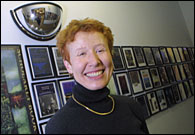Kaleidoscope
Susanne McAdam: Designing woman
 PHOTO: Owen Egan
PHOTO: Owen Egan |
|
Don't judge a book by its cover, says the old adage. Susanne McAdam hopes that you will judge books by their covers -- at least a little.
The cover alone does not a great book make, she would warrant. But if an evocative cover for one of the offerings of McGill-Queen's University Press makes you pause and pick the tome up for closer inspection, she has done her job well.
Most would agree that McAdam, the production and design manager for MQUP, does her job exceptionally well. She has helped the press win an armful of design prizes in recent years. But several years back, she was on the verge of embarking on a very different sort of career.
"I was offered a job as a blackjack dealer in a casino in Dawson City," she recalls. McAdam had already spent time in the Yukon and thoroughly enjoyed it. She leapt at the opportunity to return.
Preparing for a move, McAdam visited a friend at University of Toronto Press. The publisher was practically her next-door neighbour and she wondered if anyone there might know of someone interested in subletting her apartment.
Her U of T contact mentioned that the publisher was hiring and McAdam's background in art, translation and literature made her a good candidate. "I had unwittingly acquired the skills I needed for a career in publishing," she says. She thought about the grim and rough characters she would likely encounter each day at the blackjack table and decided that maybe the Yukon could wait.
Back then, MQUP outputted its design and production work to the U of T press. MQUP executive director Philip Cercone wanted to change that. McAdam had worked on several MQUP books and Cercone liked what he saw. He offered her a job and she made her way to Montreal in 1987.
McAdam has a lot on her plate. Together with production coordinator Elena Goranescu and intern Jennifer Appel, McAdam oversees the look and feel of up to 120 books a year. While the idea is to make them all look good, she admits that some books are more carefully put together than others. "Some books are highly specialized in their subject matter. There are about 400 people in that field who are going to buy the book regardless of what the book jacket looks like." And no else.
When a book comes along that shows the potential to appeal to a more general readership, McAdam's colleagues in editing, sales and marketing all take heed. "They pay more attention to what we're doing, because there is more at stake."
McAdam has plenty of decisions to make about each book -- where it should be printed, who will do the typesetting, what sorts of colours to use. She has to balance aesthetics with budgets and deadlines.
It's cheaper to have books printed in Singapore, but the process takes far longer. Using fewer colours saves money, so McAdam will scrimp where she can if she can also achieve an artistic payoff.
For instance, Spreading Misandry, a recent book about the negative images of men in the media, features a striking image of a man who looks like he was just belted -- the image is all the more jarring because it is in black and white.
McAdam works with a small core of freelance designers who each bring their own unique strengths. Spreading Misandry was designed by David Drummond, who actually snapped a photo of a neighbour on a trampoline for the evocative cover.
"David is very good at coming up with powerful images. Glenn Goluska is a master typographer, so I might turn to him if the book is text heavy.
"Book design requires specific skills. You have to know a lot about typography. A lot of books don't have many images and it's the type that is the main element. It's surprising how few designers know much about typography. The people we work with are book lovers."
Her own pet projects are the poetry books published through the Hugh MacLennan series. Because they are smaller books and paperbacks, they aren't all that expensive to produce, so McAdam can fuss over the details a bit more and spend money on flourishes like French flaps.
"The text itself is of a more personal nature so you get to know the authors more through their work.
"Over the last six years or so, there seems to have been a rejuvenation of interest in book design," McAdam notes. She gives part of the credit to hot Canadian designers like Bruce Mau of Zone Books fame. "Part of it is that we've also all had to become much more competitive in capturing a portion of a fairly small market."
Hazardous homes
 PHOTO: Eyewire
PHOTO: Eyewire |
|
At first glance, the notion of people falling out of their wheelchairs might not seem like much of a health care concern -- they're sitting down, after all.
But new research led by physical and occupational therapy professor Katherine Berg indicates that these tumbles happen more often than we think. And some of the falls lead to potentially dangerous injuries.
The researchers surveyed 525 male and female wheelchair users in the U.S. over the age of 18 who were living at home.
About 38% of wheelchair users fell at least once during the 12-month study period, and almost 18% suffered a fall-related injury. According to other studies, says Berg, wheelchair users are more prone to injury when they do fall.
Why do they fall in the first place? Berg thinks much of the answer relates to their home environments.
Wheelchair users are encouraged to modify their homes to make wheelchair use easier and safer -- suggested modifications include widened doorways and hallways and the addition of railings and easy-to-open doors.
But Berg's team discovered that most wheelchair users don't make the changes. She suspects the hefty price tag associated with the renovations is a major disincentive. Berg and her co-authors write, "Both safety and access would be greatly facilitated if home modifications became a reimbursable expense under Medicare, Medicaid and other health insurers."
"We should be moving to more universal designs in new homes [that would accommodate wheelchair users] but that isn't happening either," Berg adds.
She says the study, published in the American Journal of Public Health, also points to the need for physicians to ask wheelchair-bound patients more specific questions. "If your patient is already in a wheelchair, you might assume their home environment is safe. But [the patient] might actually be performing some risky manoeuvres in order to fit into the bathroom."
 |
||||
|
I prefer Buffy to The West Wing, and I'm a political scientist, for God's sake. |
||||
Ready to rumble
 ILLUSTRATION: Eyewire
ILLUSTRATION: Eyewire |
|
A lot of students with quick brains and quick mouths are heading our way.
The McGill Debating Union is hosting the North American Debating Championships from February 1 to 3. Over 200 students from across the continent will argue about everything from politics to science to religion.
Robert Sampson, president of the McGill Debating Union, says his members know their counterparts at other Canadian universities fairly well, but taking on the Yanks will be out of the ordinary.
"[American teams] often have very different views from us. We don't know what we're going to hear."
Founded in 1880, the McGill Debating Union is one of the largest debating societies in the world. One of the most successful, too.
McGill won the North American title in 1996 and has earned three national championships in the last 10 years.
They just won this year's Central Canadian Championships. "We had the top team and the top novice team. That's heartening because it show we have some new competitive blood coming in," says Sampson, a master's student in English.
He credits McGill's success to a few factors. The union hosts a big high school tournament each year that gives top young talent from across Canada a taste of the University. "Some of them are among the best young debaters around and [the tournament] gives them a chance to find out about us."
The union also puts a lot of effort into training its team members, says Sampson.
Debating Union alumni include Supreme Court justice Ian Binnie and TV magnate Moses Znaimer (Much Music, Bravo and Citytv)
What's the appeal of debating for Sampson?
"I like the theatre of it. You play a role -- you don't always agree with the position you're arguing. It's a show and it's a chance to perform."
Most events will take place in Redpath Hall. Visit the union's web site for more information: www.ssmu.mcgill.ca/debate/
 |
||||
|
Ten years ago, I knew of everybody on the planet [in haptics] and now it's become a mainstream research topic. Every big school has a haptics lab. Every big company is doing something. |
||||

